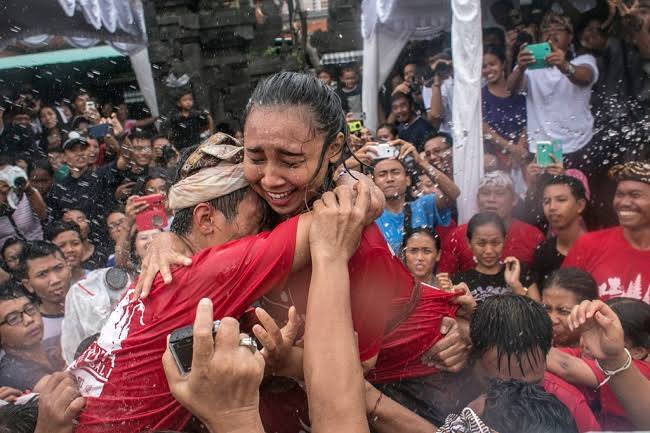Ngerebong is one of Bali’s most sacred and dramatic religious rituals, held in the heart of Denpasar at Pura Agung Petilan, Kesiman. Rich in spiritual symbolism and cultural heritage, this ancient ceremony draws locals and curious visitors alike, showcasing a unique blend of mysticism, devotion, and community unity.
What Is Ngerebong?
Ngerebong, derived from the Balinese word “ngerebong” meaning “gathering,” is a religious ceremony that seeks to restore balance between the physical and spiritual realms. It is part of the Bhuta Yadnya ritual category, which focuses on harmonizing the relationship between humans, nature, and the divine—an embodiment of the Tri Hita Karana philosophy.
The ceremony is believed to be a spiritual gathering of deities and ancestral spirits, invoked through a series of elaborate rituals and trance-induced dances. Ngerebong is exclusive to Kesiman and is deeply rooted in the identity of the local community.
When and Where It Is Held
Ngerebong takes place at Pura Agung Petilan in Desa Adat Kesiman, Denpasar. The ceremony is held every six months based on the Balinese Pawukon calendar, specifically on Redite Pon Medangsia, which falls eight days after Kuningan Day. Thousands of devotees and temple supporters gather during this time to take part in and witness the sacred events.
The Rituals and Procession
Ngerebong spans several days, with the main ritual culminating on the Redite Pon Medangsia. The ceremony begins with prayers and offerings to invite the gods and ancestors. A central aspect of the ritual is the Ngider Bhuwana, where trance-possessed devotees circle the temple courtyard multiple times, symbolizing the purification of the world.
Participants often enter a deep state of trance, known locally as kerauhan, believed to be a form of spiritual possession. In this state, they may perform ngurek—piercing their bodies with sharp kris daggers—without injury or bleeding. This phenomenon is viewed as a manifestation of divine power and spiritual protection.
The Poleng Dance: A Warrior’s Tribute
One of the highlights of Ngerebong is the sacred Tari Poleng Kesiman, a warrior dance performed by young men clad in black-and-white checkered cloth, symbolizing the cosmic balance of good and evil. The dancers, often in trance, carry traditional weapons like spears and kris, reenacting the bravery of the Kesiman kingdom’s ancestral warriors.
This dance is not just an artistic performance—it is a living ritual that honors the legacy of Kesiman’s royal lineage and reinforces spiritual fortitude among its people.
The Origins and History
Ngerebong is believed to have been formalized in 1937 under the leadership of I Gusti Ngurah Made Kesiman, although the practice itself dates back centuries. The ritual was historically associated with the royal courts of Kesiman and was later integrated into the broader religious life of the community.
The temple of Pura Petilan Kesiman, where the ceremony is centered, is considered a sacred space where ancestral spirits dwell and the gods descend during the ritual.
The Community’s Role
Ngerebong is more than a temple ritual—it is a communal act of devotion. Villagers from 34 banjars across Desa Kesiman participate in the preparation, including the creation of large decorative penjor and elaborate offerings. The unity and cooperation required to carry out the ritual reflect the strong cultural and social fabric of the community.
Beyond the ceremony itself, Ngerebong serves as a platform for intergenerational education, where elders pass down traditional knowledge, values, and spiritual understanding to the younger generation.
Spiritual and Cultural Significance
Ngerebong exemplifies Bali’s unique way of maintaining harmony between the seen and unseen worlds. Through trance, ritual, and sacred art, the community reaffirms its connection to divine forces, nature, and its ancestors. The ceremony also functions as a form of spiritual cleansing, believed to neutralize negative energies and realign the cosmic order.
As modern Bali continues to evolve, Ngerebong stands as a testament to the resilience of tradition in an increasingly globalized world.
Conclusion
The Ngerebong ceremony in Kesiman is not a spectacle for entertainment—it is a deeply sacred event that encapsulates the spiritual essence of Balinese Hinduism. For those seeking a genuine encounter with Bali’s living traditions, witnessing Ngerebong is a rare and powerful experience that offers insight into the island’s profound spiritual culture.
Whether you are a cultural enthusiast, a spiritual seeker, or a respectful observer, Ngerebong is a reminder that the soul of Bali lies not only in its landscapes, but in the rituals that have endured for generations. (BT)





